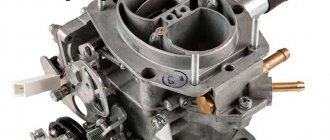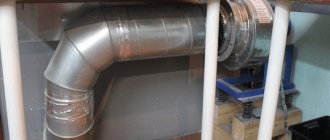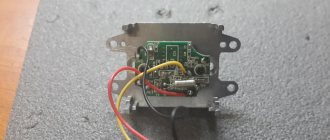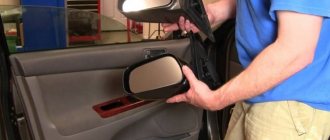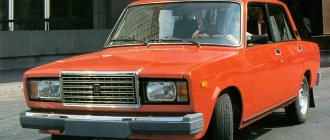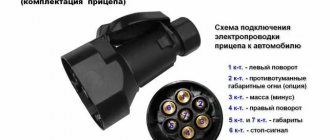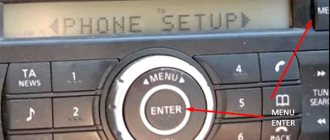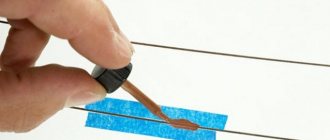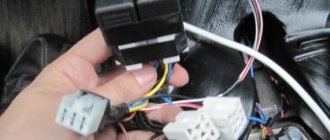Shooting sensitivity. For a wired connection, you will need to partially disassemble the interior and trunk. When choosing a camera, there are several important points to consider: Viewing angle. Usually the camera is connected to the rear lights. Connecting a monitor and rear view camera (quick connection, check) Despite its effectiveness, it is not informative enough.
This will require a special module. The device requires Android 6 to operate.
For these drivers, the solution may be to connect 2 rear view cameras.
Let's take a closer look at the classic connection option. The connection points must be perfectly insulated.
And it also turns off when reverse gear is disengaged.
5 inch monitor for rear view camera 800x480
Connecting a rear view camera yourself
There are several basic ways to connect a rear view camera in a car. The outgoing signal can be output to the display of a car radio or navigator, a head unit monitor, or to a separate screen included in the delivery package.
The last option is the simplest, since there is no problem of equipment inconsistency. At the same time, the remote screen requires a separate place in the car. The easiest way is to place the display on top of the dashboard. The second disadvantage of this option is the additional costs of equipment.
If you connect the output of the device to a monitor or radio, you save both space and money. Plus, in this case the display will be located in the most convenient place for viewing.
Installing a rear view camera yourself usually does not pose any particular difficulties. First of all, you need to decide on the type of product and its parameters. If you are going to connect the device to a car radio or navigator, you must first make sure that the equipment is compatible. The video camera’s power supply voltage, the transmitted image standard, resolution, device activation option, type of connectors, etc. may be important here.
How to choose a system
The automotive electronics market is abundantly filled with a variety of connection kits. This is especially true for products from China.
Indeed, for some owners, the quality of the transmitted picture or backlighting in the dark is not at all critical. Therefore, it is not worth paying money for unused features.
To better understand the presented devices, you need to understand the basic parameters. These include:
- Video recording resolution. The higher this parameter, the better quality the video appears on the screen. High-resolution cameras provide detailed images of the smallest objects behind the car.
- Matrix sensitivity. Sometimes this parameter is indicated by the “ISO” symbol. Cheap models are not equipped with sensitive matrices, this directly affects the image quality in the dark. The picture turns out fuzzy, it floats while moving.
- Shooting coverage. The standard viewing angle range is 120-180 degrees. A high indicator helps make the video panoramic; a large amount of space will fit into the frame. But there is an insidious point here: at such angles the real sizes of objects are distorted, which can deceive an inexperienced driver. Therefore, the optimal solution should be sought between these values.
- Camera body and installation type. Waterproof devices can be safely installed outside the car; they are not afraid of water and dirt. But they will always be available to thieves. Cameras for internal installation are installed in the luggage compartment. The space coverage will be reduced, but the device will always be dry and protected from the wrong hands.
- Connection type. The standard is a wired connection. A cable is laid from the monitor or radio to the rear of the car. More unusual is the wireless connection. The driver does not need to remove the trim and hide the wiring. But this method requires additional accessories - transmitters.
- Rear cameras with backlight function. Using such devices you can easily navigate in the dark. Illumination is performed using infrared diodes or an additional lamp. This function is useful for those cars in which the rear lights are small in size and produce weak light. Whether this type of camera is needed is up to the owner to decide individually.
It is also necessary to pay attention to the way the image is displayed. This can be a separate monitor or a 2din radio with a built-in screen. If the quality of the latter is satisfactory, there is no point in installing a second monitor.
How to connect camera wires and power
How to connect power is a rather important question and not always straightforward. There is an opinion that it is best to power the device from the reversing lights. This is often the most convenient. The camera itself is located on the car in the rear of the body. So here it is not difficult to take the 12V voltage from the rear light and connect the red wire to it. Here you can also take a minus.
Note that in order to avoid the appearance of additional potential differences, it is better to take the plus and minus from one place. This will reduce the likelihood of failures and interference with electronics.
An alternative option is to connect the camera's power directly from the on-board network, directly from the battery or through the ignition (for example, from a cigarette lighter). This method may be preferable if the video signal is sent to the monitor of the head unit.
In this case, the video camera will be constantly energized while driving, warmed up and ready for use. This improves picture quality, but may lead to overheating. Many models are designed for power supply less than 12 V. It is better to connect them via an adapter (voltage converter).
The last question is which wire or connector to connect the video output to. It all depends on the type of display device used and the connection diagram. The easiest way is if a standard RCA connector can be connected directly to the radio or navigator. Otherwise you will have to use adapters.
Below we will describe how to properly connect the video camera yourself when using different connection options.
Required tools and materials
The standard set of video cameras includes a basic set of materials used in installation work. But Chinese-made equipment is equipped with low-quality wires and terminals, which are recommended to be replaced. The set of tools depends on the design features, installation method and equipment switching. For example, there are video cameras integrated into a plastic license plate frame (model Auto Expert VC-204).
To mount a camera with your own hands to view the space behind the car, you will need the following tools and materials:
- cordless drill with a set of drills;
- drawing set for marking;
- patch cables and plugs;
- hardware products for fastening components;
- devices for removing the radio, which is used to display images on the display;
- insulating tape or heat shrink tubing.
Schemes for connecting a rear view camera to a car radio and monitor
There are two main options for connecting the camera to the radio. The first is using a separate excitation wire. This pin may be designated on the diagram and body of the car radio itself as “reverse” or “parking”.
The wiring diagram for this connection option is shown above. Here, pin P3 is supplied with +12 V from the rear light of the car. In this case, the main power can be supplied either from the same point or separately, from the on-board network.
If the design of the radio does not provide for the use of a separate excitation (or parking) signal, then activation occurs simply upon the appearance of a video signal at the input. In this case, power is taken from the rear light.
The camera is connected to the monitor in a similar way. There is one main difference here. In some cars you need to go to the engineering menu of the head unit and select the appropriate type of activation.
Features and Specifications
The viewing angle of a view camera with a monitor in the mirror characterizes how well objects located to the left and right of the vehicle will be visible. There are 2 options for installing a car mirror with a camera:
- Instead of a standard interior rear view mirror.
- As an overlay for a standard mirror using clamps.
Many mirrors with a camera have parking sensors, which makes parking the car easier in cramped conditions. A special radar, which is installed at the rear of the car and connects to the device via wire or Bluetooth, determines the distance to the nearest obstacle. Lines indicating dimensions will appear on the screen. If the device has a speaker, beeps will sound. The parking sensor function is useful for novice drivers to make maneuvering easier.
The size of the monitor built into the device can range from 3 to 6 inches. The larger the screen size, the smaller the mirror area allocated for viewing. More expensive models can be equipped with additional devices and functions, such as a navigator, clock, and video recorder. If the accessory has a built-in radar detector, the driver will be able to reduce speed in advance before approaching control equipment.
How to connect a rear view camera to a navigator
To connect to a navigator, the device must have a video input or wireless connection.
In the first case, the circuit is practically no different from that described above, with excitation via the video input (see diagram above). The only difference is that most navigators have a different type of connector. This problem can be solved using an adapter or by purchasing a video camera with the appropriate output in advance.
See below for wireless connection option.
Rating of the best models
These mirrors with monitor for view camera are in good demand and have all the necessary features. In some models, small monitors are installed under the mirror surface. Some mirrors are full-fledged video recorders with an input for a rear view camera.
Trendvision MR710GP
The built-in battery ensures autonomous operation of the device for 20 minutes. This mirror with a monitor is constantly powered from the on-board network with a voltage of 12 or 24 V. The device has a built-in 4.7-inch display located in the middle of the mirror. The built-in GPS informer warns of traffic police posts along the way. There is no navigator function.
Autoexpert DV-525
Dunobil Spiegel DUO
Interpower Silverstone f1 Interpower HD-5
SHO Me M43
The car mirror of this model is small in height, which makes it difficult to use for its intended purpose.
Connecting a wireless rear view camera
Many car enthusiasts are interested in how to connect a video camera without laying wiring in the cabin with the accompanying removal of the trim. This can be done using a wireless module. The video signal transmitter is installed next to the camera itself and is powered by the rear lights.
The receiver is placed close to the display device (car radio, navigator or monitor). This option is not suitable when using a radio with activation via a separate input.
Connecting a rear view camera via a relay
Often it becomes necessary to connect a video camera via a relay. It is not uncommon for the display to experience severe noise due to unstable voltage or the use of PWM modulation. On some cars, in the latter case, the video cameras do not start at all.
The solution is to use a relay. The plus from the rear lights is supplied to the control input of the switch. The video camera is powered from a 12 V network through the power relay contacts.
Setting up a camera with a mirror
After installing and connecting the equipment, it is advisable to configure it. Algorithms can vary significantly depending on the type of models used. Therefore, we will only mention the most basic nuance - the use of a scale grid displayed on the monitor.
This function is not available everywhere, but many models are equipped with it. After engaging reverse gear, a characteristic grid appears on the display, helping to better navigate. If it is not possible to adjust its parameters, it is necessary to at least determine the correspondence of individual lines to real distances. To do this, you need to drive close to the obstacle (until the first line of the grid “rests” against it). After that, go out and measure the actual distance between the bumper and the wall.
Where to install a rear view camera on a car
The question of where to mount the camera is also very important. It is necessary to ensure full visibility and absence of interference. It is also advisable to reduce the likelihood of vandalism and dirt and liquid getting on the device. Based on this, there are several main options for placing a video camera:
- In the license plate light. This is a very convenient option, specially provided for by the design of a number of cars.
- In the bumper. An oval or round video camera can be installed in a pre-drilled hole.
- In the trunk handle. This is especially convenient if the handle is structurally made in a common body together with a molding above the number.
- Attach the numbers to the frame.
How to set up a rear view camera on a car
Another pressing question is how to properly set up a video camera. Sometimes after installation it turns out that there is no image at all or it is “unreadable”. A possible problem is a mismatch between the video standards of the equipment. In this case, you need to use adapters (video signal adapters). Although it may be cheaper to simply buy a product of a different model.
Another possible situation is incorrectly set monitor modes. In this case, you need to switch the parameters in the engineering menu.
Even if everything works correctly, it wouldn't hurt to adjust the camera further to get parking lines on the screen. How to adjust the product depends on the characteristics of the specific model.

